| EDITOR'S NOTE: Wśród australijskich dygnitarzy obecnych podczas ceremonii odsłonięcia tzw. Tablicy Noskowskiego na Górze Kosciuszki (17 lutego 1940 roku) był H.J. Lamble, ówczesny Dyrektor NSW Government Tourist Bureau, we wczesniejszych latach menadżer słynnego, luksusowego "Hotel Kosciusko" (zbudowany w 1909 r.) w Perisher Valley. Jak wygladał "Hotel Kosciusko" prawie 90 lat temu (w roku 1928) opisuje barwnie i ze szczegółami córka Lamble'go, Olivia. W Perisher Historical Society zachowały się jej notatki z 1991 r., które niedawno odnalazł, stranskrybował i światu udostępnił Jan Glover. W obchodzonym aktualnie Roku Kościuszki warto przypomnieć nie tylko dzieje samej Góry, ale i obiektów z nią związanych.
Come, walk with me through the old Hotel Kosciusko. I see it all very clearly and want to record it in detail, even to the big ball of white quartz to the left of the steps to the entrance, near some attractive metal mud scrapers for boots. Was that quartz just so much like a big snowball, or was there some connection with an ancient legend and the marking of an entrance? Who knows? Perhaps former manager, Mr Cheeseman would have known. He had been a purser with a P&O Liner, and after handing the management of Hotel Kosciusko to my father in 1916, took up management of Sydney Hotel opposite Central Railway Station. Colonel Vernon was Government Architect for both Hotel Kosciusko and Central Railway Station in Sydney. Hotel Kosciusko was somewhat “ritzy” and to many it was “Kosi”. Imagine it in 1928.
You have arrived at the front double doorway arched by surrounds of blue grey granite, quarried from under what is now the croquet lawn opposite. You first caught sight of the hotel with its background of range upon range of snow covered mountains from a fleet of Balmain’s Cars from Cooma. They brought you through Rennix Gap, so named after the chief engineer for the Summit road from old Jyndabyne, completed in 1906. The only other buildings higher up are Smiggins road hut, and Surveyor Bett’s Camp. As you drove along towards the hotel with Panorama Peak on your right, the Pretty Point and Alpine View on your left, you passed by the old deer park and rounded the southern end of the lake, crossing the bridge over Diggers Creek in sight of platypus holes, and the dove cote, before the short climb through the golf links to the main gates, amongst a number of exotic pine trees.
The wrought iron lamps on the gates, like those at the front door lighting up the name of P.M.A. Speet, manager at the time, were seen in construction by Director, NSW Government Tourist Bureau, H. J. Lamble, when a junior clerk in the architect’s branch of the Public Works Department in Sydney. Mr Speet is on the steps to greet you and Mrs Speet waves her welcome. Mr Speet speaks to the incoming medical officer in the V.I.P. seat next to the driver, Bill Caldwell, who by now has gone through the main entrance to the Post Office, delivering the mail bag. He did not have to toss it into a box as he had done so expertly all the way along past the various properties. The outgoing medical officer joins Mr Speet and they lead the way inside to the visitors book, passing through the weather lobby, built with lead lined drainage in preparation for snowclad skis, and then swing doors before the vestibule.
There are porters busily unloading luggage with green labels and taking it inside, separated from luggage with red labels for the outgoing trip. There are groups of people enjoying the sunshine on the croquet lawn beneath the flagpost on which they fly the flags of the schools in residence – Fort Street, Sydney Grammar and Sydney High School. There has been competitive interschool racing on the Kerry Course, and cross country racing at Dainer’s Gap during the week.
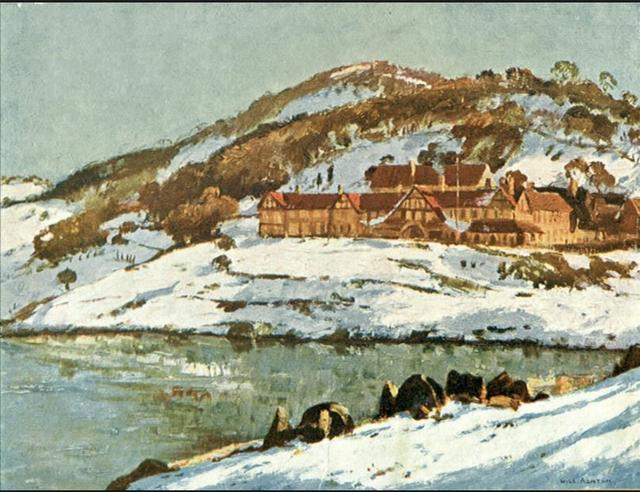
Will Ashton - Kosciusko Hotel in Perisher Valley |
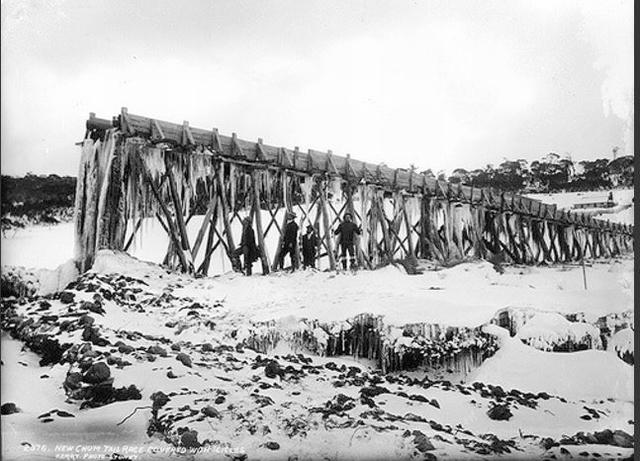
Nechum Tail Race covered with icicles ca.1900 |
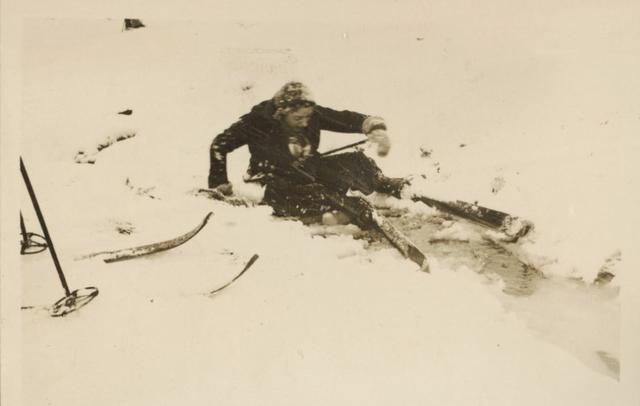
What a crash. September 1937 |
The tours of the Australian School Ski Clubs are organized by the Government Tourist Bureau together with the schools, and a wonderful week to the hotel from the time of departure from Central Railway, as described in H. J. Lamble’s article in the 1928 Australian Ski Year Book, has been most successful in popularizing the sport in this country. The history and development of the sport in Australia has been covered in the 1928 Australian Ski Year Book edited by Percy Hunter, who at the turn of the century had been entrusted by Premier Sir Joseph Carruthers with the opening up of the snowfield at Kosciusko.
The 1928 edition was the first combined publication on behalf of the ski clubs of that time. In the following year it was published on behalf of the newly formed Ski Council of N.S.W. comprising the Kiandra Ski Club, the Kosciusko Alpine Club, the Ski Club of Australia, the Mills Ski Club, the University Ski Club, the R.A.C. Ski Club and the Public Service Ski Club.
An article about famous photographer and enthusiast for the introduction of Sydney people to the winter sports at snowshoe carnivals in Kiandra, announced the recent death of Charles Kerry, the Father of skiing and tobogganing at Kosciusko in 1909.
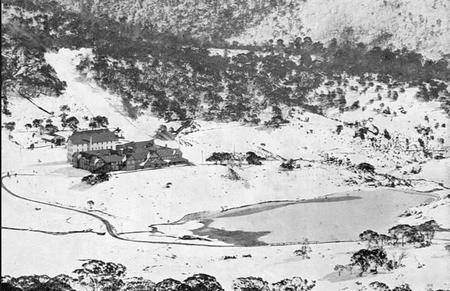
|
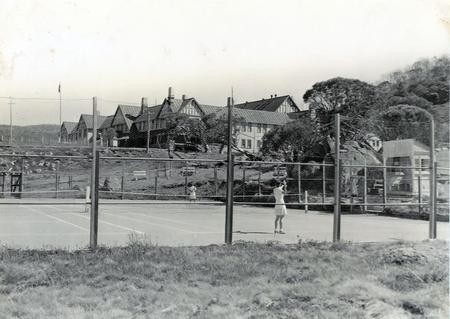
|
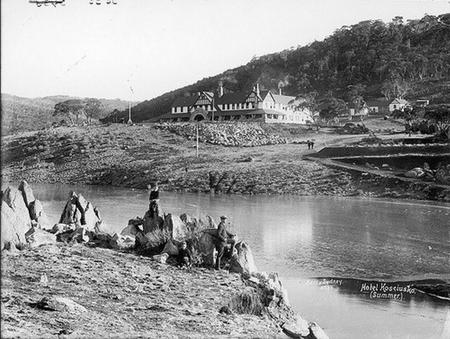
|
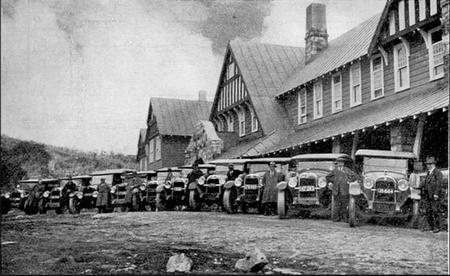
|
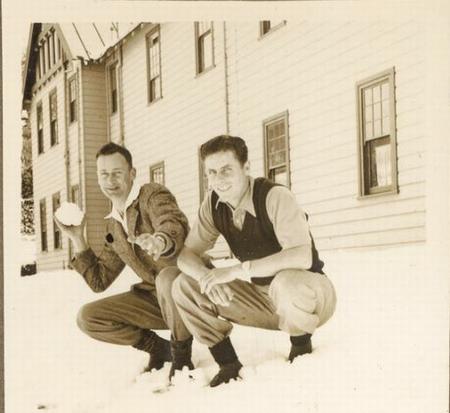
|
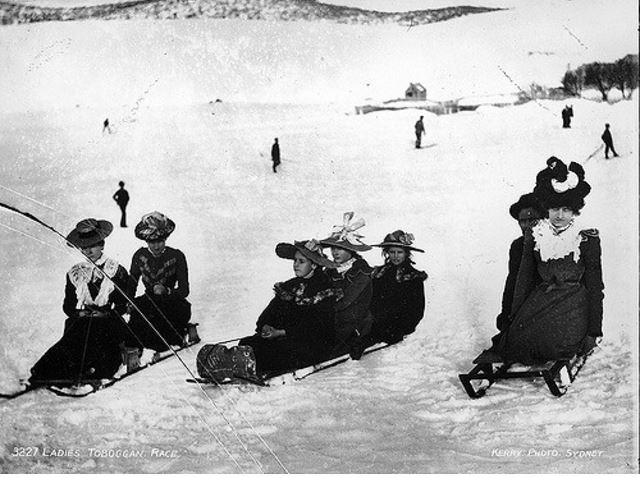
|
In 1897 [Charles] Kerry with his camera and snowshoe party reached the summit of Mt Kosciusko and members of that party formed the nucleus of the N.S.W. Alpine Club in Kiandra. The 1928 Year Book carried a coloured print of Will Ashton’s painting of Hotel Kosciusko with its latest 1927 addition, the new most up to the date laundry within the new staff quarters, now restored as Sponar’s Lakeside Inn, following the fire which burnt the hotel to the ground in 1951.
Once inside the vestibule you are aware of a crackling log fire in the ingle on your right where young people are exchanging autographs. In a flash you take in the maroon colour of withdrawn woollen curtains edged with pom poms, the maroon leather upholstery and blue prints of Kerry’s historic photographs. There is an aroma of eucalyptus from an arrangement of red gum tips in bronze jardinière on central table, lit up by rays of sunlight all the way down the stairwell, from high up courtyard windows. There were happy people on the carpeted stairs, some checking appearances in the full length wall mirror on the first landing, on either side of which were Prince of Wales feathers arranged in shapely, tall blue and white delft vases. Others were studying the very large topographical maps on the wall showing the high country from the summit and main ranges down to the Thredbo and Snowy River areas.
New Kosciusko Hotel called Sponar's
ABC story about the fire, audio report
ABC local stories
http://www.google.com.au/maps/@-36.3578885,148.4892366,17z?hl=en
www.sponars.com.au/
www.perisher.com.au/accommodation/35/Perisher-Road/Sponars-Chalet/about
Tom the Tapper (alias Baker) in bottle green serge suit trimmed at neck and cuffs with red and gold crowns sounded the luncheon gong with his drumstick. When he took the gong from the Porter’s room under the stairs you noticed a row of Brasso tins and cloths for the polishing of the numerous door handles and surrounds to the fireplace. With pen and ink from a leather inkwell you signed the visitor’s book by the screen of scenic photographs and were ushered with your luggage to your room to make ready for lunch.
Old Tom was a Kosci favourite with his morning call, “Come on Boys and Girls – Rise and shine”. We placed flowers from our garden on his grave on a visit to the old Jyndabyne Cemetery after his death when Balmain’s Bus driver let us down at the gates and waited for our return. Tom was a migrant from Northumberland and with his friend Sam, and their packhorse was on the Kosci Road looking for work, when H.J. Lamble met them before 1920. H.J. Lamble was driving the manager’s horse and sulky to inspect the hotel annex at “The Creel” on Thredbo (River). He promised them work as kitchenmen and said proceed to the Hotel. It was on such outings that my mother selected choice young eucalyptus gum tips for the vases in the hotel.
At the sound of Tom’s gong, people collecting mail from the wall letter rack of green felt criss-crossed by red tape, moved through the open doors of the spacious, sparkling dining room, warmed by two large log fires; one in the centre of the far wall near the wine bar, and another between the swing doors to the courtyard corridor and kitchen. There were a few classical prints on the walls, and mantle shelves with various fine art pieces including equestrian statues. On the left were a number of alcoves looking onto the verandah, which was the extent of the original 1909 dining room.
After the 1911 additions and alterations there was open space to the French windows where deer used to sometimes appear for loaf sugar and where Aroline the goose would tap his beak on the glass. The tables covered with white shiny starched damask cloths, and serviettes folded in chef’s cap shapes, were set with heavy silver cutlery and dishes of various shapes and sizes, for example for butter balls made by the use of butter pats. Tumblers and glass jugs of bubbly water were on each table and in the centre of each stood a tall silver vase filled with fresh blue gums. On the sideboards were grouped silver fruit stands with fruits in season, dried fruits, nuts in shells with nut crackers, in silver dishes.
Sunday dinners every day, and Christmas dinner every Sunday induced H.J. Lamble’s enthusiasm for applying for the position as manager in 1916. They also gave the guests the necessary energy for their activities on the snow. The Menu Cards read: “Some have meat but canna eat and some would eat that want it: but we have meat and we can eat and so the Lord be thanked.” In 1928 the cards had Will Ashton’s painting viewing the buildings from the golf links with skiers in jodhpurs and coloured woollen clothing around the gates at the foot of the Mt Vernon Course named after Colonel Vernon. An historic photograph in 1908 shows Percy Pearson and other Kiandra Skiers at that spot with the Dept of Works Caretaker. Bon appetit. After lunch meet me in the courtyard corridor to continue with this history and inspection of rooms of a mansion that people before the turn of the century considered a fantastic dream.
Olive Lamble
Source: Perisher Historical Society
Hotel Kosciusko (Perisher Valley, at Diggers Creek) was destroyed in a fire in 1951. New hotel was built on the ruins of the old one. Its new name is Sponar's.
"Sponar's ski accommodation is situated at 1500 meters altitude in the Kosciuszko National Park, just 8 kilometers from Perisher Ski Resort. Sponar's is an owner operated Chalet. It is a historic, well known landmark, a traditional ski lodge offering a unique snow holiday. Our lodge sits on the site of the original Kosciuszko Hotel whose Grand Slam Ski run was the first commercial ski slope in the Snowy Mountains area, just 24 kilometers from Jindabyne."
| 

